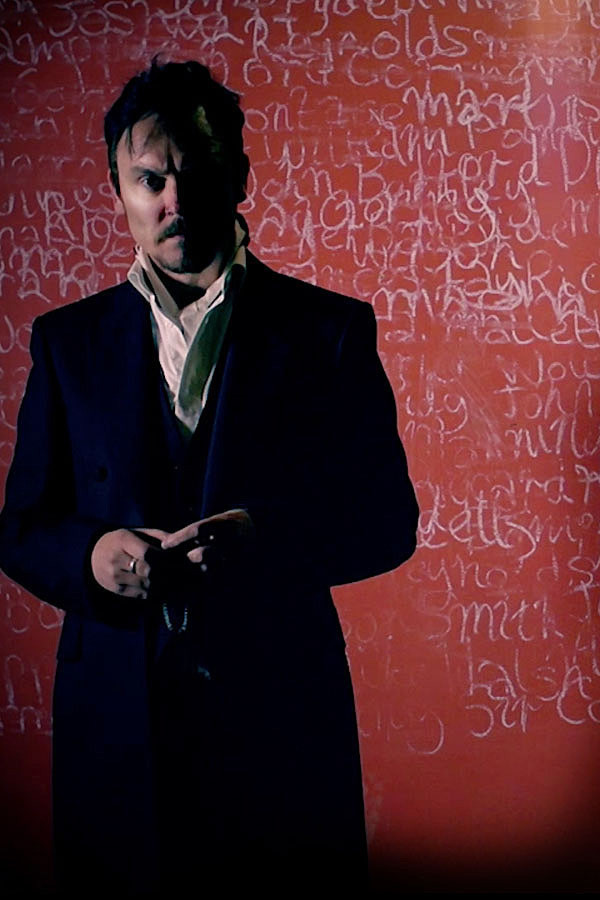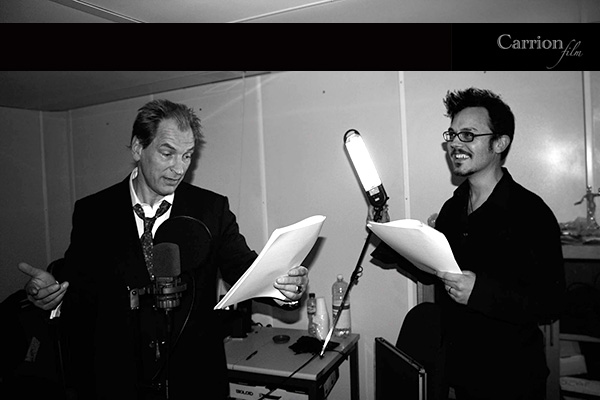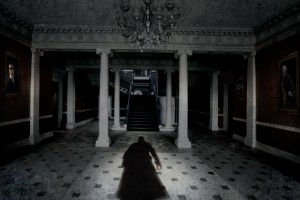 Splatter Cinema presents VIDEODROME (1983); Dir. David Cronenberg; Starring James Woods, Deborah Harry and Jack Creley; Tuesday, March 11 @ 9:30 p.m. (photos and merch booth open @ 9:00 p.m.); Plaza Theatre; Trailer here.
Splatter Cinema presents VIDEODROME (1983); Dir. David Cronenberg; Starring James Woods, Deborah Harry and Jack Creley; Tuesday, March 11 @ 9:30 p.m. (photos and merch booth open @ 9:00 p.m.); Plaza Theatre; Trailer here.
By Aleck Bennett
Contributing Writer
It’s one of those great instances when a bloody, nightmarish horror flick gives you something important to chew on afterwards. Splatter Cinema is back at the Plaza Theatre to take a mind-bending trip into the head of David Cronenberg with what may be his best film to date, VIDEODROME!
I’ve got something I want to play for you.
There are horror movies, and there are horror movies. And then, there are David Cronenberg movies. Easily one of the most facile writers/directors in blending the highbrow and lowbrow, his films typically explore themes and concepts that appeal to the art film crowd while simultaneously delivering the kind of gut-level shocks and bloody special effects that made his movies a mainstay in the pages of FANGORIA. And while other films of his may have appealed to broader audiences and been more financially successful, or even dealt with headier concepts (like the nature of humanity itself in THE FLY), nothing compares to his masterpiece, VIDEODROME.
I’m looking for something that will break through. Something tough.
–Max Renn
It’s 1983 Toronto, and Max Renn needs new programming for his TV station, channel 83 or CIVIC-TV. (“CIVIC-TV: the one you take to bed with you!”) His associate Harlan, who runs the station’s pirate satellite receiver and descrambles international broadcast feeds, calls Max down to his office to show him a curious new program seemingly originating out of Malaysia: Videodrome. It’s nothing but brutal violence. No plot. No story. And if it’s faked, it’s very realistically done. But it also carries a strange mind-control signal, and Max soon finds himself hallucinating wildly and caught in a war between the two parties who want control of Videodrome.
The television screen is the retina of the mind’s eye. Therefore, the television screen is part of the physical structure of the brain. Therefore, whatever appears on the television screen emerges as raw experience for those who watch it. Therefore, television is reality, and reality is less than television.
–Professor Brian O’Blivion
Central to the plot of the movie are the philosophical statements of Professor Brian O’Blivion, one of the co-creators of Videodrome. Based upon Marshall McLuhan (whom Cronenberg had studied under at university), his in-film theories about the extension of “the screen” as a new part of how we view the world take the film far beyond just a tale of good and evil and into an examination of how we process what we expose ourselves to. In the Professor’s view, television is integral to functioning as a society, and his daughter extends this theorizing into the brick-and-mortar world by running the Cathode Ray Mission, devoted to allowing the city’s homeless to watch TV in order to better acclimate them to the world we live in. They’re not only showing their flock what the world is like, but the reality that the rest of the world is embracing so that they can better fit in. Ultimately, the Professor’s philosophy comes down to a central question: who is programming the signal you’re tuning into? Are you passively allowing others to create your reality, or are you seizing autonomy and programming it yourself?
I think we live in overstimulated times. We crave stimulation for its own sake. We gorge ourselves on it. We always want more, whether it’s tactile, emotional or sexual. And I think that’s bad.
–Nicki Brand
If there is a single criticism I have of Cronenberg’s questioning, it is that it’s possibly too naïve. I think he raises numerous issues that have real relevance to our contemporary media fascination, but he didn’t (and quite probably couldn’t) have predicted the extent to which the screen has come to dominate our lives. I mean, how long has it been since you’ve looked away from the screen on which you are reading this article? How long will it be before you look at another screen—a TV, your phone, your tablet, your laptop? How much screen time do you log in at your job? And, further, what is your emotional relationship with those screens? How many friends do you have whom you only contact through the screen? How many acquaintances have you made via Facebook, Twitter or Tumblr that you have never physically met? Are those people—and the feelings you have for them—any less real because they seem to only exist in pixels and sets of ones and zeroes? How much of your reality is dictated by the screen you are looking at right now? And, back to Cronenberg’s question, who is in control of what you are seeing?
But why would anybody watch it? Why would anybody watch a scum show like Videodrome?
–Barry Convex
In the world of the film, control of the Videodrome signal is in the hands of Barry Convex, head of Spectacular Optical (“We make inexpensive glasses for the third world and missile guidance systems for NATO. We also make Videodrome, Max.”). Covex wants to toughen up North America by ridding it of the kind of degenerate low-lifes who would get off on a show like Videodrome. And it’s between the idealistic O’Blivion (who believes that the Videodrome signal can be used to create a new, direct relationship between video and our bodies) and the fascistic Convex that Renn finds himself, his programming being rewritten by both sides. From the film’s start, Max’s programming and re-programming results in violent hallucinations. We, the viewers, are never entirely sure if what we’re seeing is objective reality or Max’s imagined reality brought on by video feed. But as O’Blivion states, there is no real difference. Reality is entirely subjective, and our perceptions dictate what our reality consists of. (And, anyway, the ultimate irony is that there is no objective reality we are viewing—we are watching an imagined scenario enacted by James Woods, Debbie Harry, et al. and directed by David Cronenberg. Note how many frames we see within the film, informing us that what we are watching is constantly being framed by unseen hands.)
 This film is the first of a Cronenberg trilogy that wrestles with the questions of addiction, the subjective nature of “reality” and whether the distinction between the real and imagined makes any difference. In this film, the addiction is to the screen. The other two films are NAKED LUNCH (in which William Lee’s submission to addiction and descent into drug-induced hedonism in the Interzone blur the lines between fantasy and reality) and EXISTENZ (which basically transposes the storyline of VIDEODROME into the immersive world of video games). Clearly, the issues of releasing control of your own programming to outside sources and who is ultimately responsible for crafting your own reality loom large in Cronenberg’s artistic output.
This film is the first of a Cronenberg trilogy that wrestles with the questions of addiction, the subjective nature of “reality” and whether the distinction between the real and imagined makes any difference. In this film, the addiction is to the screen. The other two films are NAKED LUNCH (in which William Lee’s submission to addiction and descent into drug-induced hedonism in the Interzone blur the lines between fantasy and reality) and EXISTENZ (which basically transposes the storyline of VIDEODROME into the immersive world of video games). Clearly, the issues of releasing control of your own programming to outside sources and who is ultimately responsible for crafting your own reality loom large in Cronenberg’s artistic output.
What are you waiting for, lover? Let’s perform. Let’s open those neural floodgates.
–Nicki Brand
Legend has it that Cronenberg was inspired to make this film after a viewing of Joe D’Amato’s infamous 1977 sexploitation flick EMANUELLE IN AMERICA. The film contains a snippet of an 8mm torture loop that leads journalist Emanuelle to uncover an international snuff film ring. The seemingly incongruous inclusion of this brutal footage in what was billed as a Big Sexy Movie (the matter is introduced and dropped at the tail end of the picture with no real justification) led Cronenberg to explore that juxtaposition in VIDEODROME. And while it may be easy to see the film as a criticism of the media’s exploitation of sex and violence to entice viewers, Cronenberg is more complex than that. He doesn’t really take a stand for or against it. While our hero Max Renn glibly defends his TV station’s programming as catharsis for viewers who can’t turn to the real world to vent their subconscious (interesting, given that the Videodrome signal breaks down the barrier between TV and the “real“ world and unleashes that catharsis across what becomes a false boundary), he is also depicted as a total sleaze, so it’s hard to take his explanation at face value.
 But Cronenberg himself, outside of the film, has long used a potent mix of eroticism and brutality as the materials with which he crafts his films. Whether it’s the murderous hedonism of SHIVERS, porn star Marilyn Chambers spreading violent madness in RABID or the car accident fetishism of CRASH, Cronenberg has long embraced the taboo duo of sex and violence in his work. So it’s not a blanket condemnation of the raw materials he’s engaging in, but a criticism of intent. In the film, witnessing extreme violence makes the viewer more open to receiving the Videodrome signal, and thus easier for Convex’s team to control or subdue. Cronenberg isn’t asking the viewer to eschew the primal pleasure that comes from viewing sex and violence, but to question why it’s being presented; to, again, seize autonomy and control your programming.
But Cronenberg himself, outside of the film, has long used a potent mix of eroticism and brutality as the materials with which he crafts his films. Whether it’s the murderous hedonism of SHIVERS, porn star Marilyn Chambers spreading violent madness in RABID or the car accident fetishism of CRASH, Cronenberg has long embraced the taboo duo of sex and violence in his work. So it’s not a blanket condemnation of the raw materials he’s engaging in, but a criticism of intent. In the film, witnessing extreme violence makes the viewer more open to receiving the Videodrome signal, and thus easier for Convex’s team to control or subdue. Cronenberg isn’t asking the viewer to eschew the primal pleasure that comes from viewing sex and violence, but to question why it’s being presented; to, again, seize autonomy and control your programming.
So, yeah. This is a heavy flick. Deals with some weighty issues. But it’s also wildly entertaining. VIDEODROME handles its subject matter with a fair dose of wit and satire. While it’s ultimately a grim parable, James Woods’ high-energy performance rockets the movie along at a brisk pace. With an actor even a slight bit more leaden than Woods, the film would slow to a crawl and collapse under its own weight. Debbie Harry as Nicki Brand delivers a memorable performance that would never lead you to believe that she was a relative newcomer to acting. It’s one of the few believable “rock star-to-actor” transitions you’ll see. Cronenberg effectively captures the scenes of S&M between Woods and Harry with the right combination of disturbing frankness and eroticism, while Rick Baker’s effects work ratchets up the film’s increasingly surreal tone. (Never before has a TV cabinet been more sexual!) Some of the film’s visuals—particularly the flesh-gun that Woods’ hand becomes—evoke the nightmarish visions of H.R. Giger. It is one of the few movies that would play just as well at MOMA or in some grindhouse theater of years gone by. It’s a masterpiece from one of the cinema’s most accomplished directors. It is not to be missed.
But be careful. It bites.
Long live the new flesh.
Aleck Bennett is a writer, blogger, pug warden, pop culture enthusiast, raconteur and bon vivant from the greater Atlanta area. Visit his blog at doctorsardonicus.wordpress.com










